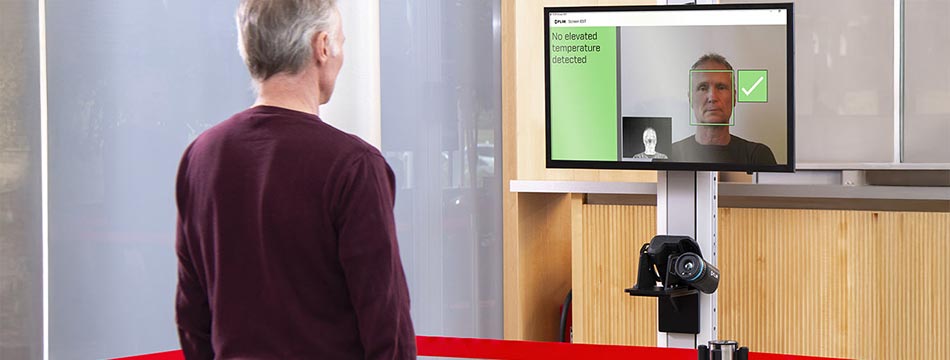
Please note that this blog was originally published on the 12th June 2020. It was updated on the 3rd November 2020 to reflect current infection and death statistics and to include new FLIR and Testo Thermal Imaging Cameras.
In late 2019 the first known cases of COVID-19 were reported in the Chinese city of Wuhan. Since then it has quickly spread around the globe and was declared a pandemic by the World Health Organisation (WHO) on the 11th March 2020. Over 46 million cases have been confirmed in 190 countries resulting in approximately 1.2 million deaths worldwide (as of 3rd November 2020).[1]
Quick Links
- Introduction
- Why Use a Thermal Camera or IR Thermometer?
- How Do Thermal Cameras and IR Thermometers Work?
- Which Thermal Cameras and IR Thermometers are Suitable for Temperature Screening?
- Non-Contact IR Thermometers
- Handheld/ Tripod-Mounted Temperature-Screening Thermal Cameras
- Fixed/ Tripod-Mounted Temperature-Screening Thermal Cameras
- Stand-Alone Plug & Play Temperature-Screening Solutions
- Security & Access Control Temperature-Screening Solutions
- Further Information
Introduction
To achieve herd immunity and prevent the continuation of this pandemic, it is approximated that a minimum of 60% to 70% of the population needs to be immune to the Sars-CoV-2 virus, the current COVID-19 coronavirus. Experts suggest it may take between 18 and 24 months for herd immunity to occur naturally.[2]
However, over 100 experimental vaccines are in development across the globe. Most scientists estimate that it will take a minimum of 12 to 18 months before a functional Sars-CoV-2 vaccine is readily available.[3] Nevertheless, Sarah Gilbert, Professor of Vaccinology at Oxford University, is optimistic that, in the event of a best-case scenario, her team could produce a vaccine as early as September 2020.[4]
In the meantime, it is vital to prevent the spread of COVID-19 to protect healthcare systems, families and businesses. This is especially important as countries slowly begin to emerge from lockdown. Professor David Heymann of the London School of Hygiene and Tropical Medicine advises that while we live with the virus the public will have to get used to extensive infection monitoring and rapid containment of outbreaks.[5] Indeed, the World Health Organisation (WHO) has continually stressed the importance of detecting and testing people with possible symptoms, as well as tracing those that test positive for COVID-19. The WHO has also highlighted the importance of innovation in the face of this virus.[6]
Infrared technology, such as thermal cameras and IR thermometers, provides an innovative, simple, fast and non-invasive method of monitoring people for possible symptoms of COVID-19. This technology can be easily implemented in a range of public and professional settings such as offices, businesses, factories, hotels, restaurants, schools, campuses, stations, airports, hospitals, and care homes.
Why Use a Thermal Camera or IR Thermometer?
It is important to note that thermal cameras and IR thermometers CANNOT diagnose coronavirus or any other illness; however, they can identify persons with a high skin-surface temperature which may indicate a fever, a common symptom of COVID-19.[7] Individuals with higher-than-average skin-surface temperature may need to self-isolate and undergo further medical testing. Therefore, thermal imaging cameras and IR thermometers can help to streamline medical screening and protect the public from further spread infection.
IR thermometers and thermal imaging cameras are able to measure skin-surface temperatures accurately, usually within ±0.3-0.5˚C, and are equipped with alarms that are triggered when out-of-range body temperatures are detected (e.g. 37.5˚C or above).
Moreover, as thermal cameras and IR thermometers perform non-contact temperature measurements, both those screening and those being screened are protected against the possible transmission of infection. (Please note that IR thermometers require a much shorter distance-to-target, 3-15cm, and therefore cannot offer the same protection as a thermal camera, 0.8-2m.)
Manufacturers such as Hikvision, FLIR and Seek Thermal also offer a range of remote temperature-screening solutions which eliminate contact between screening staff and the public, again preventing potential transmission of infection. Additionally, these systems are often able to screen high-volumes of people within a short period of time.
How Do Thermal Cameras and IR Thermometers Work?
IR thermometers and thermal cameras utilise the principle of emissivity. They measure the amount of infrared energy/ light emitted by an object and convert that into a temperature measurement and/or thermal image.
Emissivity indicates how well an object radiates heat or infrared energy. The emissivity scale ranges from 0, reflects all energy, to 1, perfectly absorbs and radiates all energy. Human skin sits on this scale at about 0.98; for comparison, highly polished metallic surfaces have an emissivity of less than 0.1. Please see the following video for further information.
Which Thermal Cameras and IR Thermometers are Suitable for Temperature Screening?
Over the course of our nineteen-year trading history, PASS Ltd has cultivated close relationships with leading thermal camera and IR thermometer manufactures including FLIR, Seek Thermal, Hikvision, Testo, Extech and UNI-T. With Level 1 Thermographers on hand to offer advice, PASS Ltd can help you find the best temperature-screening solution for your needs.
Temperature-Screening Thermal Cameras
When purchasing a thermal imaging camera for the purposes of body-temperature screening, one should consider the range, resolution and sensitivity of the imager as well as its ergonomics and suitability for the prospective application or environment.
Thermal imaging cameras optimised for body-temperature screening must have a temperature range that encompasses 30°C to 45°C.
The thermal sensitivity of the camera indicates the smallest temperature difference it can detect and illustrate on the IR image. The lower the NETD (Noise Equivalent Temperature Difference) value the greater the thermal camera’s sensitivity; for instance, a thermal camera with a NETD value of 50mK will be more sensitive than a thermal camera with a NETD value of 60mk or 80mk. FLIR recommends thermal cameras with a sensitivity of 50mk or lower when taking body-temperature readings.[8]
The thermal camera's IR resolution indicates the number of measurement points in the thermal image: the higher the IR resolution the greater the number of pixels and therefore measurement points. For example, a thermal camera with an IR resolution of 160 x 120 has a total of 19 200 pixels/ measurement points, whereas a thermal camera with an IR resolution of 320 x 240 has a total of 76 800 pixels/ measurement points. A thermal camera with more pixels/ measurement points has a greater chance of attaining an accurate temperature reading; its thermal image will also be clearer and contain more detail.
Please see below for further information regarding our range of IR thermometers and temperature-screening handheld thermal cameras, mounted thermal cameras, and plug & play systems, as well as combined temperature-screening and access control/ security solutions.
Non-Contact IR Thermometers
| Pros | Cons |
| Easy-to-use | Must be used inside and within specific conditions |
| Ergonomic | Short distance-to-target (3-15cm) increases the risk of transmission |
| Economic | Not capable of remote temperature-screening |
| Accurate: ±0.3°C | No thermal image |
| Fast temperature measurement | |
| Clear go/ no-go audible and visual alarms |
Ideal for screening persons before they enter offices, call centres or schools, IR thermometers are easy-to-use, accurate and efficient. PASS Ltd currently offers the following models suitable for taking body-temperature measurements:
- Extech IR200 Non-Contact Forehead Thermometer
- TestSafe Medical Forehead and Body Temperature Infrared Thermometer (SKU: TS-TM501)
All of these models can measure skin-surface temperature to an accuracy of at least ±0.3°C and feature a temperature alarm with audible and visual alerts. The alarm is triggered when an abnormal, potentially unhealthy reading has been detected.
Both the TestSafe Medical (SKU: TS-TM501) and UNI-T UT305H IR Thermometers feature pre-programmed colour go/ no-go alarms: in-range temperatures are indicated by a green light whereas out-of-range temperatures are indicated by a red light. This allows the user to evaluate body-temperatures quickly and act accordingly. The Extech IR200 Non-Contact Forehead Thermometer differs slightly as it includes an adjustable alarm, allowing the user to tailor the thermometer to his/her company’s policy.
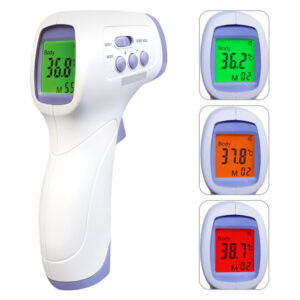
All of the aforementioned IR thermometers can ascertain temperatures quickly. However, the person being screened must stand within 3 to 15cm (model dependent) of the thermometer which increases the risk of transmission. The UNI-T UT305H Non-Contact Infrared Forehead Thermometer offers a solution to this: it can be tripod-mounted allowing the user to increase the distance between himself/herself and the individual being screened.
Non-contact infrared IR thermometers are ergonomic, economic, easy-to-use and efficient body-temperature measuring tools. They are suitable for use at home or in small offices, call centres and schools.
Handheld/ Tripod-Mounted Temperature-Screening Thermal Cameras
Handheld/ Tripod-Mounted Temperature-Screening Thermal Cameras are more efficient than IR thermometers and have a greater distance-to-target (0.8-2m), making it easier to maintain compliance with social distancing guidelines. Most of these cameras can also be mounted on a tripod, increasing the distance between the user and the people being screened.
Temperature-screening thermal imaging cameras provide both a temperature reading and a heat map of the person’s face, allowing the user to evaluate skin-surface temperatures and heat distribution quickly. A majority of these models also feature adjustable temperature alarms with clear go/ no-go alerts, again adding to the efficiency and ease of temperature screening.
Like the aforementioned infrared thermometers, these thermal imaging cameras are ideal for premises that have fewer individuals to check such as offices, schools, and hospitality and catering establishments.
| Pros | Cons |
| Easy-to-use | More expensive than an IR thermometer |
| Efficient | Can only screen one person at a time |
| Provides multiple measurement points | Requires a tripod to increase the distance between the user and those being screened |
| Provides a thermal image as well as a temperature reading | Some models require the user to have an understanding of the basic principles of thermography |
| Includes a dedicated temperature-screening function | |
|
Issues both an audible and visual alert |
|
|
Can be used in all light conditions, including the dark |
|
|
Typical distance-to-target: 0.8-2m |
Hikvision Handheld Temperature-Screening Thermal Cameras
PASS Ltd stocks two Hikvision Handheld Temperature-Screening Thermal Cameras both of which are supplied with a tripod and A3 fever-screening stand:
- Hikvision DS-2TP31B-3AUF Temperature-Screening Thermal Camera
- Hikvision DS-2TP21B-6AVF/W Body Temperature Handheld Thermal Camera
Both pistol-design models have a NETD sensitivity of <40mK, an IR resolution of 160 x 120, providing 19 200 measurement points, and will display a colour highlight alarm when an out-of-range temperature is measured. The Hikvision DS-2TP21B-6AVF/W Body Temperature Handheld Thermal Camera will also issue an audio alarm and includes a 16GB built-in memory; the Hikvision DS-2TP31B-3AUF Temperature-Screening Thermal Camera is supplied with an 8GB removable memory card.
Furthermore, the Hikvision DS-2TP21B-6AVF/W Body Temperature Handheld Thermal Camera includes an 8MP visual-light camera and has a slightly longer distance-to-target, 1-2m, compared to the Hikvision DS-2TP31B-3AUF Temperature-Screening Thermal Camera’s 0.8-1.2m.
Please see the video below for a comparison of the Hikvision DS-2TP31B-3AUF Temperature-Screening Thermal Camera and an IR thermometer.
FLIR Exx Series Handheld Thermal Imaging Cameras
FLIR’s E76, E86, and E96 are pistol-shaped thermal imaging cameras fitted with an EST (Elevated Skin Temperature) function that will alert the user when individuals with above-average skin temperature are detected. FLIR’s Exx Series and T Series (see below) are FDA approved for use alongside other body-temperature screening tools for the purposes of detecting differences in skin-surface temperature.[9]
The FLIR Exx series have a thermal sensitivity (NETD) of <40mk to <30mk (model dependent) and a distance-to-target of 1-2m. Their IR resolutions range from 240 x 180, providing 43 200 detection points (E53), to 640 x 480, providing 307 200 detection points (E96). Additionally, the FLIR Exx Series Handheld Thermal Imaging Cameras can be purchased with a choice of lenses.
FLIR T Series Thermal Imaging Camera
Like the above Exx Series, the FLIR T530, T540, and T1020 Thermal Imaging Cameras have been fitted with an EST function and can be used to identify abnormal skin-surface temperatures (compared to the sample average). Similarly, these cameras can be purchased with a range of lenses and have a distance-to-target of 1-2m. The FLIR T Series Thermal Imaging Cameras can also be fixed to a tripod allowing the user to increase the distance between himself/ herself and the person being screened.
The FLIR T Series has a thermal sensitivity of <30mk; the cameras' IR resolutions range from 320 x 240, providing 76 800 measurement points (T530), to 1024 x 768, providing 786 432 measurement points (T1020).
For more information regarding FLIR’s EST function, available on the FLIR Exx and T Series Thermal Imaging Cameras and FLIR A320 (see below), please see the following video.
Testo 885 & 890 Thermal Imaging Cameras
The Testo 885 & 890 Thermal Imaging Cameras with a 42° wide-angle lens can be purchased with a FeverDetection function which measures relative temperatures in order to identify individuals who may have an elevated body temperature. Persons being screened should stand between 1 and 2m away from the camera. These cameras, like the aforementioned FLIR and Hikvision handheld thermal cameras, can be tripod mounted to increase the distance between those being screened and those screening. Please see the video below for an introduction to Testo's FeverDetection function.
The Testo 885 Thermal Imaging Camera has an IR resolution of 320 x 240, providing 76 800 measurement points, and has a thermal sensitivity of 30mk. The Testo 890 Thermal Imaging Camera has an IR resolution of 640 x 480, providing 307 200 measurement points, and a 40mk thermal sensitivity.
Fixed/ Tripod-Mounted Temperature-Screening Thermal Cameras
PASS Ltd offers a selection of fixed and tripod-mounted thermal imaging cameras by leading manufacturers such as Hikvision and FLIR. These cameras can be used to screen high volumes of people quickly and remotely, making it easy to maintain compliance with social distancing guidelines. Some models, such as Hikvision’s Temperature-Screening Bullet and Turret Thermal Cameras can be used to screen multiple people simultaneously. These fixed/ tripod-mounted temperature-screening thermal cameras can be integrated into existing security monitoring systems/ VMS and are ideal for implementation in indoor locations with a high footfall, such as large offices, factories, hotel lobbies, shopping malls, building entrances, train and bus stations, and airports.
| Pros | Cons |
|
Rapid screening |
Some models are expensive |
| Some cameras can screen multiple people simultaneously | Some models require the user to have an understanding of the principles of thermography |
| Suitable for locations with high volumes of people | Require time-consuming installation and configuration |
| Greater distance-to-target for maintaining social distancing | |
| Support for remote monitoring eliminating contact between the person screening and persons being screened | |
|
Clear temperature alarms |
|
|
Some models provide radiometric thermal images (each pixel has a temperature measurement) |
|
|
Can be used in all light conditions, including darkness |
Hikvision Temperature-Screening Turret and Bullet Thermal Cameras
These combined IR and visual-light cameras enable multiple people to be screened simultaneously, efficiently and accurately. It is possible to mount Hikvision’s DS-2TD1217B Turret Thermal Cameras to a ceiling or tripod; whereas Hikvision’s DS-2TD2617B and DS-2TD2636B Bullet Thermal Cameras can be mounted on a wall or tripod.
All of the Hikvision Temperature-Screening Turret and Bullet Thermal Cameras feature an alarm function that will indicate the presence of an abnormal/ unhealthy skin temperature using a colour alert. It is also possible to connect these temperature-screening thermal cameras to an audible alarm that will be triggered when the camera detects an out-of-range temperature, enabling staff to act quickly and reducing the possibility of missed alerts.
In addition to this, we offer a selection of exclusive Pro Solutions and Solutions Kits which include all the equipment needed to set up an effective and reliable body-temperature screening station.
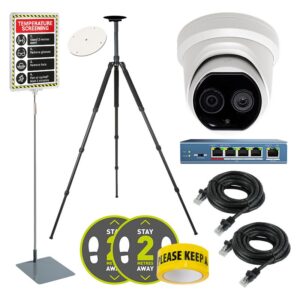
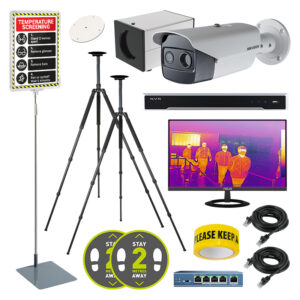
Hikvision’s low-res DS-2TD1217B Turret Thermal Cameras and DS-2TB2617B Bullet Thermal Cameras have a thermal sensitivity of ≤40mk and an IR resolution of 160 x 120, providing up to 19 200 measurement points. Hikvision’s high-res DS-2TD2636B Bullet Thermal Cameras offer an IR resolution of 384 x 288, providing 110 592 detection points, and have a thermal sensitivity of ≤40mk; the DS-2636B-10/P model with a 9.7mm lens has a thermal sensitivity of ≤35mk. All these cameras can be used with Hikvision’s DS-2TE127-G4A Black Body to improve their accuracy and reliability.
Hikvision’s Temperature-Screening Bullet and Turret Thermal Cameras can be purchased with a selection of lenses: the smaller the lens the smaller the distance-to-target. All these cameras make it easy to maintain social distancing as their distances-to-target range from a minimum of 0.8m-1.5m (DS-2TD1217B-3/PA) up to a maximum of 2.5-9m (DS-2TD2636B-15/P); please see the table below for further details.
| Model | Lens Size |
Recommended Distance Between Human & Camera |
| DS-2TD1217B | 3.1mm |
0.8-1.5m |
| 6.2mm | 1.5-3m | |
| DS-2TD2617B | 3.1mm | 0.8-1.5m |
| 6.2mm | 1.5-3m | |
| DS-2TD2636B | 9.7mm | 2-7m |
| 15mm | 2.5-9m |
For further information regarding Hikvision’s Bullet and Turret Temperature-Screening Thermal Imaging Cameras, as well as some of Hikvision’s handheld models, please see the following video.
FLIR A320 Temperature Screening IR Camera
Several FLIR A320 Temperature Screening IR Cameras can be used together to monitor large areas, making them suitable for temperature-screening applications in busy places such as train and bus stations and airports. The FLIR A320 Temperature Screening IR Camera can also be integrated into existing machine vision and automation systems and can be operated remotely via the web or TCP/IP protocols, enabling users to adhere to social distancing guidelines.
This thermal imaging camera captures radiometric IR images, providing the user with a temperature reading for each pixel. The FLIR A320 Temperature Screening IR Camera has an IR resolution of 320 x 240, providing 76 800 pixels/ measurement points, and has a thermal sensitivity of 50mK. Like the FLIR Exx and T Series Thermal Cameras, it features an EST function for detecting abnormal skin temperatures (compared to the sample average). When this camera detects an anomalous temperature, its onboard intelligence will generate a digital alarm and send an email alert to a designated receiver.
FLIR A400, A500 & A700 EST Thermal Cameras
The FLIR A400, A500 and A700 are completely customisable thermal imagers; these EST models have been specifically configured for elevated skin-surface temperature screening and include a 24˚ lens, Wi-Fi connectivity and advanced smart sensor software including EST (Elevated Skin Temperature) technology.
Like the FLIR A320, the FLIR A400, A500 and A700 EST Thermal Cameras capture radiometric images and have a thermal sensitivity of <50mK to <40mK (model dependent). Their infrared resolutions range from 320 x 240 (A400), which provides 76 800 measurement points, to 640 x 480 (A700), which provides 307 200 temperature points. Moreover, these thermal cameras can be used with a black body to ensure continued accuracy and reliability.
The FLIR A400, A500 and A700 EST Thermal Cameras can be integrated into new or existing networks and thermal footage can be streamed wirelessly enabling remote temperature-screening. The FLIR A400, A500 and A700 EST Thermal Cameras’ EST technology will alert the user when an out-of-range, potentially unhealthy skin-surface temperature is measured.
Stand-Alone Plug & Play Temperature-Screening Solutions
Efficiency and ease of implementation are often key factors when deciding on a temperature-screening solution. The aforementioned fixed/tripod-mounted temperature-screening thermal cameras must be installed and configured and so require some technical and thermal knowledge. However, both Seek Thermal and Hikvision offer a number of plug & play temperature-screening solutions which do not require complex configuration or installation; they can be set up within minutes.
Stand-alone plug & play temperature screening-solutions can be connected to a monitor or computer allowing staff to see thermal data and footage without coming into close contact with those being screened. These efficient temperature-screening solutions feature clear abnormal temperature alerts and, whilst they can only screen one person at a time, are able to determine temperature measurements within seconds. These simple, fast and precise temperature-screening solutions are ideal for implementation in ordered but busy indoor environments such as airports, train and bus stations, care homes, schools, and the entrances to offices, gyms, theatres and arenas.
| Pros | Cons |
|
Require little to no installation or configuration |
Some models are expensive |
| Can be set up within minutes | Can only screen one person at a time |
| Rapid temperature measurements | |
| Clear pass/ fail temperature alerts | |
| Supports remote and/or socially distant screening | |
|
Combined temperature-screening and access control solutions available |
|
|
Combined temperature-screening and metal detecting solutions available |
|
|
Suitable for security applications |
|
| Suitable for busy environments |
Seek Scan Thermal Body Temperature Screening Solution
A Windows PC and two tripods are all that is required to use this Seek Thermal temperature-screening system. Connection to a Windows PC enables remote monitoring and therefore compliance with social distancing guidelines, while clear PASS/FAIL indications improve the efficiency of fever-screening as the Seek Scan Thermal Body Temperature Screening Solution evaluates temperature measurements for the user allowing him/her to act quickly.
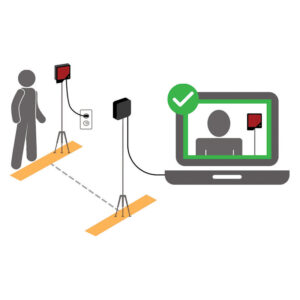
The Seek Scan Thermal Body Temperature Screening Solution automatically takes skin-temperature readings upon detection of a human face; it is able to determine skin-surface temperature within seconds and automatically saves this data along with the pass or fail result and a visual and thermal picture. Inclusion of a heat source, which functions as a kind of black body, ensures the Seek Scan thermal camera remains accurate and reliable, while alterable alarm limits allow the user to tailor the Seek Scan Thermal Body Temperature Screening Solution to his/her company’s policy.
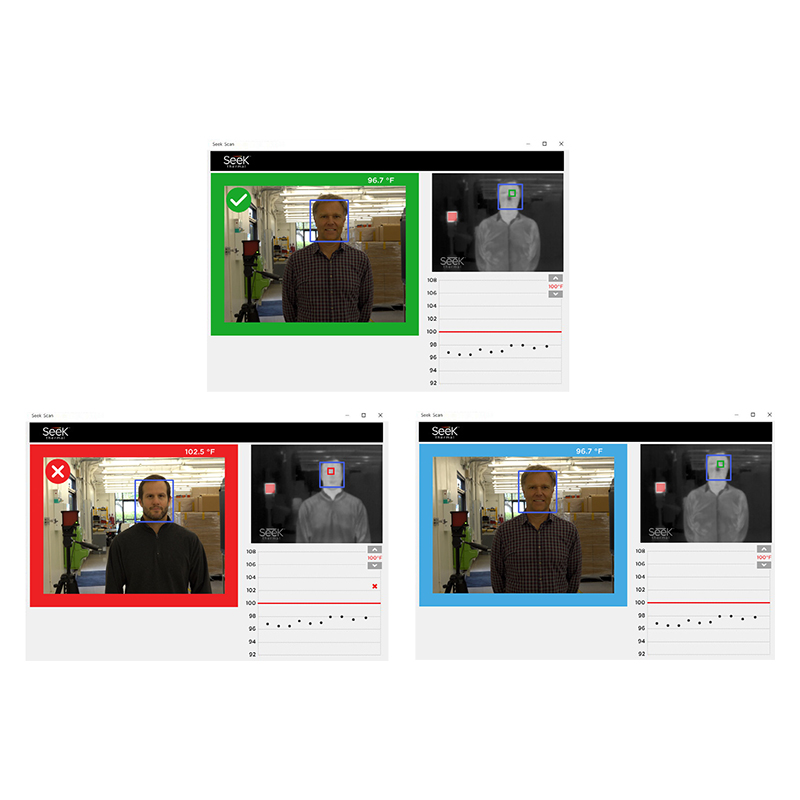
Finally, the Seek Scan Thermal Body Temperature Screening Solution has an IR resolution of 206 x 156, providing 32 136 measurement points, and a 40mk-50mk thermal sensitivity.
Hikvision Plug & Play Thermal Temperature-Screening Scanner with Metal Detector
The Hikvision Plug & Play Thermal Temperature-Screening Scanner with Metal Detector consists of a Hikvision DS-2TD1217B-3/PA Temperature-Screening Turret Camera mounted on a metal-detecting door frame. This combined temperature-screening and security solution enables remote and socially distanced screening. It is easy to install and configure enabling fast deployment.
The picture below illustrates one of the ways the Hikvision Plug & Play Thermal Temperature-Screening Scanner with Metal Detector can be set up.
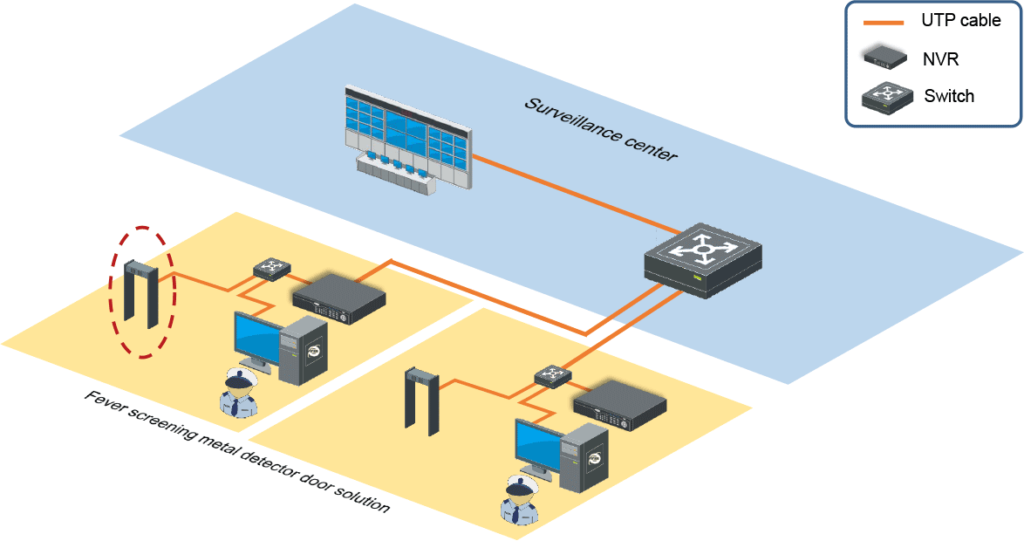
The Hikvision Plug & Play Thermal Temperature-Screening Scanner with Metal Detector has a thermal sensitivity of ≤40mk and an IR resolution of 160 x 120, providing 19 200 measurement points. Temperature readings are indicated on the large LCD display along with the people count, metal alarm count and abnormal temperature count. When an out-of-range temperature is measured, the Hikvision Plug & Play Thermal Temperature-Screening Scanner with Metal Detector will issue an audible and visual alarm.
Similarly, the Hikvision Plug & Play Thermal Temperature-Screening Scanner with Metal Detector will alert the user to the presence of metal using red LEDs which illuminate at the approximate level of the metal object; for instance, if a watch is detected the lights at wrist-height will shine red. This highly sensitive metal detector is compliant with international safety standards ensuring that it can safely screen pregnant women and people with cardiac pacemakers.
The Hikvision Plug & Play Thermal Temperature-Screening Scanner with Metal Detector is both a temperature-screening and security solution, making it suitable for conducting checks at concert/ sports venues, exhibitions, conferences, museums, airports and stations.
Hikvision DS-K5604A-3XF/V Plug & Play MinMoe Temperature-Screening Terminal with Stand
The Hikvision DS-K5604A-3XF/V Plug & Play MinMoe Temperature-Screening Terminal with Integrated Stand is a combined temperature-screening and access control instrument. It is supplied ready-assembled and does not require installation, configuration or wiring, allowing it to be set up within five minutes.
The Hikvision DS-K5604A-3XF/V Plug & Play MinMoe Temperature-Screening Terminal enables access to a room or building when particular conditions have been met, e.g. the person is a recognised face and is deemed to have a healthy temperature. The Hikvision DS-K5604A-3XF/V Plug & Play MinMoe Temperature-Screening Terminal also includes two optional face mask alarms and can be set to issue a reminder or deny access if the individual is not wearing a face mask.
The Hikvision DS-K5604A-3XF/V Plug & Play MinMoe Temperature-Screening Terminal includes a Vanadium Oxide uncooled sensor for conducting temperature measurements and has an IR resolution of 120 x 160, providing 19 200 measurement points. It has a distance-to-target of 0.3 to 2m.
When an abnormal, potentially unhealthy temperature is measured the Hikvision DS-K5604A-3XF/V Plug & Play MinMoe Temperature-Screening Terminal will issue a voice alert; additionally, it can be programmed to deny entry to the room or building. The Hikvision DS-K5604A-3XF/V Plug & Play MinMoe Temperature-Screening Terminal will automatically begin temperature screening upon detection of a human face and will upload online and offline temperature measurements to the user’s software, allowing temperature-screening to be conducted remotely.
Similarly, the Hikvision DS-K5604A-3XF/V Plug & Play MinMoe Temperature-Screening Terminal will upload face recognition data to the user’s software. It is able to determine face recognition within 0.2s and has an accuracy of 99%.
The Hikvision DS-K5604A-3XF/V Plug & Play MinMoe Temperature-Screening Terminal can also be connected to a card reader to enable card recognition and is suitable for attendance monitoring.
The Hikvision DS-K5604A-3XF/V Plug & Play MinMoe Temperature-Screening Terminal is ideal for use in offices, factories, lobbies and building entrances.
Security & Access Control Temperature-Screening Solutions
| Pros | Cons |
|
Efficient temperature measurements |
More expensive than IR thermometers and some handheld thermal cameras |
| Clear pass/ fail alerts | Can only screen one person at a time |
| Supports remote and/or socially distant screening | Requires configuration and installation |
|
Suitable for access control/ security applications |
|
|
Suitable for public/ professional places with a low to medium footfall |
Hikvision DS-K1T671TM-3XF Face Recognition & Temperature-Screening Terminal
The Hikvision DS-K1T671TM-3XF Face Recognition & Temperature-Screening Terminal includes all the capabilities and features of the above Hikvision DS-K5604A-3XF/V Plug & Play MinMoe Temperature-Screening Terminal, including a Vanadium Oxide uncooled sensor and an IR resolution of 120 x 160. However, the Hikvision DS-K1T671TM-3XF Face Recognition & Temperature-Screening Terminal also includes a built-in card reader for card recognition and, unlike the Hikvision DS-K5604A-3XF/V Plug & Play MinMoe Temperature-Screening Terminal, it is not supplied ready assembled.
The Hikvision DS-K1T671TM-3XF Face Recognition & Temperature-Screening Terminal is specifically designed for access-control/ security applications and temperature-screening making it ideal for installation in offices, factories, campuses, libraries, lobbies, and building entrances.
Further Information
For further information regarding any of the aforementioned IR thermometers, thermal imaging cameras and temperature-screening solutions, please contact our sales team on 01642 931 329 or via our online form.
[1] BBC News, Covid-19 pandemic: Tracking the global coronavirus outbreak, last accessed 03 November 2020 <https://www.bbc.co.uk/news/world-51235105>
[2] Aylin Woodward ‘The COVID-19 pandemic could last for 2 years according to US experts’, World Economic Forum, last accessed 23 May 2020 <https://www.weforum.org/agenda/2020/05/coronavirus-pandemic-last-2-years/>
[3] BBC News, Coronavirus: Children and older adults to take part in vaccine trial, last accessed 23 May 2020 <https://www.bbc.co.uk/news/health-52760871?intlink_from_url=&link_location=live-reporting-story>
[4] Alice Thompson, Rachel Sylvester, Chris Smyth, Oliver Wright, ‘Coronavirus vaccine could be ready by September’, The Times, last accessed 23 May 2020 <https://www.thetimes.co.uk/article/coronavirus-vaccine-could-be-ready-by-september->
[5] Ian Sample, ‘We might not get a coronavirus vaccine’, The Guardian, last accessed 23 May 2020 <https://www.theguardian.com/world/2020/may/22/why-we-might-not-get-a-coronavirus-vaccine>
[6] Tedros Adhanom, ‘WHO Director General’s opening remarks at the media briefing on COVID-19 – 11th March 2020’, World Health Organisation, last accessed 24 May 2020 <https://www.who.int/dg/speeches/detail/who-director-general-s-opening-remarks-at-the-media-briefing-on-covid-19---11-march-2020>
[7] NHS, Symptoms and What to Do: Coronavirus (COVID-19), last accessed 26 May 2020 <https://www.nhs.uk/conditions/coronavirus-covid-19/check-if-you-have-coronavirus-symptoms/>
[8] FLIR, Answers: Using FLIR for elevated skin temperature screening, last accessed 04 June 2020 <https://flir.custhelp.com/app/answers/detail/a_id/3539/~/using-flir-for-elevated-skin-temperature/session/>
[9] FLIR, Thermal Imaging for Detecting Elevated Body Temperature, last accessed 10 June 2020 < https://www.flir.co.uk/discover/public-safety/thermal-imaging-for-detecting-elevated-body-temperature/ >


